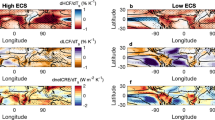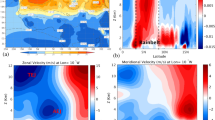Abstract
Atmospheric blocking is a key component of extratropical weather variability1 and can contribute to various types of extreme weather events2,3,4,5. Changes in blocking frequencies due to Arctic amplification and sea ice loss may enhance extreme events6,7, but the mechanisms potentially involved in such changes are under discussion8,9,10,11. Current theories for blocking are essentially based on dry dynamics and do not directly take moist processes into account12,13,14,15,16,17. Here we analyse a 21-year climatology of blocking from reanalysis data with a Lagrangian approach, to quantify the release of latent heat in clouds along the trajectories that enter the blocking systems. We show that 30 to 45% of the air masses involved in Northern Hemisphere blocking are heated by more than 2 K—with a median heating of more than 7 K—in the three days before their arrival in the blocking system. This number increases to 60 to 70% when considering a seven-day period. Our analysis reveals that, in addition to quasi-horizontal advection of air with low potential vorticity12,13,14,15, ascent from lower levels associated with latent heating in clouds is of first-order importance for the formation and maintenance of blocking. We suggest that this process should be accounted for when investigating future changes in atmospheric blocking.
This is a preview of subscription content, access via your institution
Access options
Subscribe to this journal
Receive 12 print issues and online access
$259.00 per year
only $21.58 per issue
Buy this article
- Purchase on Springer Link
- Instant access to full article PDF
Prices may be subject to local taxes which are calculated during checkout




Similar content being viewed by others
References
Rex, D. Blocking action in the middle troposphere and its effect on regional climate. I: An aerological study of blocking. Tellus 2, 169–211 (1950).
Carrera, M. L., Higgins, R. W. & Kousky, V. E. Downstream weather impacts associated with atmospheric blocking over the Northeast Pacific. J. Clim. 17, 4823–4839 (2004).
Sillmann, J. & Croci-Maspoli, M. Present and future atmospheric blocking and its impact on European mean and extreme climate. Geophys. Res. Lett. 36, L10702 (2009).
Pfahl, S. & Wernli, H. Quantifying the relevance of atmospheric blocking for co-located temperature extremes in the Northern Hemisphere on (sub-)daily time scales. Geophys. Res. Lett. 39, L12807 (2012).
Pfahl, S. Characterising the relationship between weather extremes in Europe and synoptic circulation features. Nat. Hazards Earth Syst. Sci. 14, 1461–1475 (2014).
Liu, J., Curry, J. A., Wang, H., Song, M. & Horton, R. M. Impact of declining Arctic sea ice on winter snowfall. Proc. Natl Acad. Sci. USA 109, 4074–4079 (2012).
Francis, J. A. & Vavrus, S. J. Evidence linking Arctic amplification to extreme weather in mid-latitudes. Geophys. Res. Lett. 39, L06801 (2012).
Screen, J. A. & Simmonds, I. Exploring links between Arctic amplification and mid-latitude weather. Geophys. Res. Lett. 40, 959–964 (2013).
Barnes, E. A., Dunn-Sigouin, E., Masato, G. & Woolings, T. Exploring recent trends in Northern Hemisphere blocking. Geophys. Res. Lett. 41, 638–644 (2014).
Hassanzadeh, P., Kuang, Z. & Farrell, B. F. Responses of midlatitude blocks and wave amplitude to changes in the meridional temperature gradient in an idealized dry GCM. Geophys. Res. Lett. 41, 5223–5232 (2014).
Coumou, D., Petoukhov, V., Rahmstorf, S., Petri, S. & Schellnhuber, H. J. Quasi-resonant circulation regimes and hemispheric synchronization of extreme weather in boreal summer. Proc. Natl Acad. Sci. USA 111, 12331–12336 (2014).
Shutts, G. J. The propagation of eddies in diffluent jetstreams: Eddy vorticity forcing of ‘blocking’ flow fields. Q. J. R. Meteorol. Soc. 109, 737–761 (1983).
Hoskins, B. J. & Sardeshmukh, P. D. A diagnostic study of the dynamics of the Northern Hemisphere winter of 1985–86. Q. J. R. Meteorol. Soc. 113, 759–778 (1987).
Nakamura, H., Nakamura, M. & Anderson, J. L. The role of high- and low-frequency dynamics in blocking formation. Mon. Weath. Rev. 125, 2074–2093 (1997).
Yamazaki, A. & Itoh, H. Vortex–vortex interactions for the maintenance of blocking. Part I: The selective absorption mechanism and a case study. J. Atmos. Sci. 70, 725–742 (2013).
Masato, G., Hoskins, B. J. & Woolings, T. J. Wave-breaking characteristics of midlatitude blocking. Q. J. R. Meteorol. Soc. 138, 1285–1296 (2012).
Tyrlis, E. & Hoskins, B. J. Aspects of a Northern Hemisphere atmospheric blocking climatology. J. Atmos. Sci. 65, 1638–1652 (2008).
Barnes, E. A., Slingo, J. & Woolings, T. A methodology for the comparison of blocking climatologies across indices, models and climate scenarios. Clim. Dynam. 38, 2467–2481 (2012).
Ferranti, L., Corti, S. & Janousek, M. Flow-dependent verification of the ECMWF ensemble over the Euro-Atlantic sector. Q. J. R. Meteorol. Soc. 141, 916–924 (2015).
Tilly, D. E., Lupo, A. R., Melick, C. J. & Market, P. S. Calculated height tendencies in two Southern Hemisphere blocking and cyclone events: The contribution of diabatic heating to block intensification. Mon. Weath. Rev. 136, 3568–3578 (2008).
Cheung, H. N. et al. Observational climatology and characteristics of wintertime atmospheric blocking over Ural-Siberia. Clim. Dynam. 41, 63–79 (2013).
Schwierz, C. Interactions of Greenland-scale Orography and Extratropical Synoptic-Scale Flow PhD thesis, ETH Zurich (2001)
Croci-Maspoli, M. & Davies, H. C. Key dynamical features of the 2005/06 European winter. Mon. Weath. Rev. 137, 664–678 (2009).
Schwierz, C., Croci-Maspoli, M. & Davies, H. C. Perspicacious indicators of atmospheric blocking. Geophys. Res. Lett. 31, L06125 (2004).
Croci-Maspoli, M., Schwierz, C. & Davies, H. C. A multifaceted climatology of atmospheric blocking and its recent linear trend. J. Clim. 20, 633–649 (2007).
Wernli, H. & Davies, H. C. A Lagrangian-based analysis of extratropical cyclones. I: The method and some applications. Q. J. R. Meteorol. Soc. 123, 467–489 (1997).
Scherrer, S. C., Croci-Maspoli, M., Schwierz, C. & Appenzeller, C. Two-dimensional indices of atmospheric blocking and their statistical relationship with winter climate patterns in the Euro-Atlantic region. Int. J. Climatol. 26, 233-249 (2006).
Madonna, E., Wernli, H., Joos, H. & Martius, O. Warm conveyor belts in the ERA-Interim data set (1979–2010). Part I: Climatology and potential vorticity evolution. J. Clim. 27, 3–26 (2014).
Methven, J. Potential vorticity in warm conveyor belt outflow. Q. J. R. Meteorol. Soc. 141, 1065–1071 (2015).
Gray, S. L., Dunning, C. M., Methven, J., Masato, G. & Chagnon, J. M. Systematic model forecast errors in Rossby wave structure. Geophys. Res. Lett. 41, 2979–2987 (2014).
Dee, D. P. et al. The ERA-Interim reanalysis: Configuration and performance of the data assimilation system. Q. J. R. Meteorol. Soc. 137, 553–597 (2011).
Tibaldi, S. & Molteni, F. On the operational predictability of blocking. Tellus A 42, 343–365 (1990).
Acknowledgements
We thank MeteoSwiss for providing access to ECMWF analysis data. Discussions with H. Davies have been very helpful in designing this study. C.M.G. acknowledges support from the Swiss National Science Foundation (Grant PZ00P2_148177/1).
Author information
Authors and Affiliations
Contributions
All authors designed the study and discussed the results and manuscript. S.P. analysed the data. S.P. and H.W. wrote the manuscript.
Corresponding author
Ethics declarations
Competing interests
The authors declare no competing financial interests.
Supplementary information
Supplementary Information
Supplementary Information (PDF 1815 kb)
Rights and permissions
About this article
Cite this article
Pfahl, S., Schwierz, C., Croci-Maspoli, M. et al. Importance of latent heat release in ascending air streams for atmospheric blocking. Nature Geosci 8, 610–614 (2015). https://doi.org/10.1038/ngeo2487
Received:
Accepted:
Published:
Issue Date:
DOI: https://doi.org/10.1038/ngeo2487
This article is cited by
-
A Perspective on the Evolution of Atmospheric Blocking Theories: From Eddy-Mean flow Interaction to Nonlinear Multiscale Interaction
Advances in Atmospheric Sciences (2023)
-
Contrast responses of strong and weak winter extreme cold events in the Northern Hemisphere to global warming
Climate Dynamics (2023)
-
Prediction and projection of heatwaves
Nature Reviews Earth & Environment (2022)
-
Moisture sources of heavy precipitation in Central Europe in synoptic situations with Vb-cyclones
Climate Dynamics (2022)
-
Energetics of Boreal Wintertime Blocking Highs around the Ural Mountains
Journal of Meteorological Research (2022)



